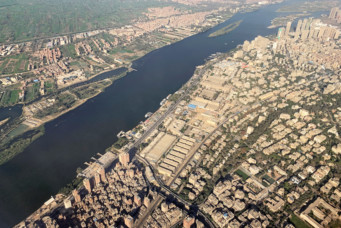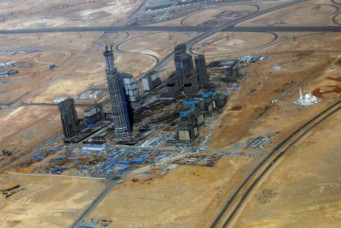Good to the Last Drop
Why nature-based solutions and adaptive management may hold the key to water conservation in the MENA region

A rooftop garden in the neighborhood of Hattaba in Islamic Cairo, Egypt, Dec. 2019. Audrey Lodes/Cairo Review
In 1907, Theodore Roosevelt was asked how his cup of coffee tasted, to which he responded “good to the last drop”. The Middle East and North Africa (MENA) region is exhausting its limited water resources, and without adaptive management and alternative water sources will soon reach the “last drop”. This threatens the future of humanity in this region, as the UN recognized in 2010 by declaring that access to water and sanitation (termed the “human right to water and sanitation” or HRWS) is a basic human right due to its necessity for sustaining human life. Many MENA countries always had scarce surface waters, mainly springs, that were quickly diminished or totally lost to pumping of groundwater for agriculture. In 1990 and before placing significant curbs on pumping, Saudi Arabia had forty-six active springs. It now has only fifteen.
Major aquifers of the region containing “fossil water” from moderate climate periods thousands of years ago have been significantly reduced in size and volume to a point where they are no longer viable water sources. Nations have recently resorted to building expensive desalination plants to supply their basic water demands. Even nations relying on major rivers (the Nile, Tigris, or Euphrates) as traditionally inexhaustible sources of water have seen both the quantity and predictability of water threatened by climate change and increased human demands in the multiple countries they flow through. Current water sources are either too expensive or too threatened politically to be wasted.
The water-energy-food nexus is the accepted standard for evaluating the three sectors governing resource sustainability and their interactions at the national level. Most MENA countries are struggling in at least two sectors, food and water, with the situation expected to become progressively worse throughout the remainder of this century. Average per capita water availability has declined by 85 percent since 1950, with twelve countries currently suffering from an absolute shortage. The challenge is to embrace adaptive management in the face of climate change and population pressures to avoid total societal collapse and political instability, as have happened in Yemen and Syria.
The shift from surface and groundwater resources to dependance on expensive desalination alternatives clearly points to the urgent necessity of finding alternative water resources throughout the region. Rainwater harvesting, especially of rare but significant storm runoff, can add to water resources, but reuse is the only feasible alternative water resource for most of the region. Desalinated water is simply too expensive to use once and discard.
Wastewater Treatment and Reuse
Currently, 86 percent of water resources in MENA are used for agriculture. Although only 50 percent of wastewater in the region is treated, 83 percent of that volume is used for irrigated agriculture, while urban and peri-urban agriculture rely exclusively on untreated wastewater. Sixty percent of the MENA’s total population is concentrated in urban areas; 15 countries have greater than 70 percent of their populations in cities. Such highly urbanized populations present a dilemma. Although it becomes easier to collect wastewater, the cost of conventional treatment options is extremely high, and it is difficult for traditional infrastructure to keep up with population demographics.
Egypt has invested in traditional infrastructure and has 146 treatment plants with a new plant under construction that has a capacity exceeding that of all its other treatment plants combined to treat both urban and agricultural wastes for reuse. Sadly, while a significant investment, Egypt will not be able to keep up with expanding population growth, the finite life of treatment plants, and expected climate change. Treatment infrastructure will have a positive impact on wastewater generated by middle and upper class areas, but rapidly expanding irregular developments by the marginalized poor crowding into metropolitan areas will remain without treatment options.
This author has proposed key agenda items for the COP27 climate conference sponsored by the UN and held in Egypt in 2022 that recognized the critical need to consider water quantity, quality, and reuse issues, and the importance of nature-based solutions for promoting sustainability in the water-energy-food nexus. Sadly, the focus of the conference was on climate and population impacts on water quantity, with little attention to designing with nature to provide alternative sources of water for both urban populations and agriculture. Nature-based solutions (NBS) provide cost-effective and equally reliable wastewater treatment as traditionally engineered infrastructure, and unlike the latter do not have a finite lifespan of operation. They do not rely on the large-scale, highly centralized treatment of wastes and can be adapted to meet population demographics and specific contaminants from agriculture and industry in parallel with climate change impacts. Examples of NBS options include rooftop gardens and green-walled buildings to treat grey and stormwater in urban centers, and constructed wetlands for wastewater treatment. Unlike traditional engineered infrastructure, NBS can serve multiple purposes including nature conservation, passive recreation, agriculture, product development, and water reuse.
Nature-based Solutions as Alternative Water Resources
NBS treatment can be tailored to meet the quality concerns of the anticipated user—from irrigation requiring the lowest quality water, to potable water requiring extremely high quality. For the latter, constructed wetlands are often operated in tandem with traditional engineering infrastructure, either to handle waste overloading the system or to improve the treatment quality of aging, poorly maintained infrastructure. Constructed wetlands are used extensively globally where infrastructure construction and operation cannot keep up with urban expansion. Given the additional cost for water consumers, regardless of treatment option, urban and peri-urban farmers often resist moves to treat wastewater because of traditional reliance on raw sewage as their irrigation source at little or no cost.
Although state-of-the-art wastewater treatment removes most contaminants, it also removes essential nutrients needed for plant growth and can actually reduce agricultural productivity. Convincing subsistence farmers to switch to treated wastewater is a daunting problem as they lack the funds to pay for water, while being willing to take a chance with contamination from free wastewater.
MENA nations relying partially or solely on desalinated water have begun to recognize the futility of single use of such expensive resources, and the need to maximize recycling of generated wastewater. While advanced wastewater treatment plants can be highly efficient at resource recovery, they are energy-intensive and raise the question as to whether the added recycling cost of already expensive water has any advantage over single use desalinated water.
The potential of constructed wetlands to treat wastewater and add to local water resources can be significant. The amount of wastewater generated annually by the current population of the MENA (approximately 583 million), assuming 60 m3 per capita per annum, is 34,980,000,000 m3. If passed through constructed wetlands for treatment and accounting for a 70 percent water loss via evapotranspiration during passage, 10,494,000,000 m3 of recycled water could be added to the water resources base for the region at a fraction of the cost of conventional treatment facilities.
Adaptive management is a strategy that focuses on a frequent reassessment of environmental conditions as programs develop, and on adapting resources to promote environmental and human sustainability in the face of challenges like population growth and climate change. Increased reliance on desalination plants to meet domestic and agricultural water demands is without question, but emphasis on nature-based solutions—especially constructed wetlands— to reduce wastewater treatment costs and add recycled water to the resource base must be considered critical. It is clear that rapidly increasing urbanization not only increases demands on water resources in the MENA, but also makes supplementing water resources via nature-based solutions a critical component of the overall approach. The key link in the success of this approach is governance and adaptive management.





